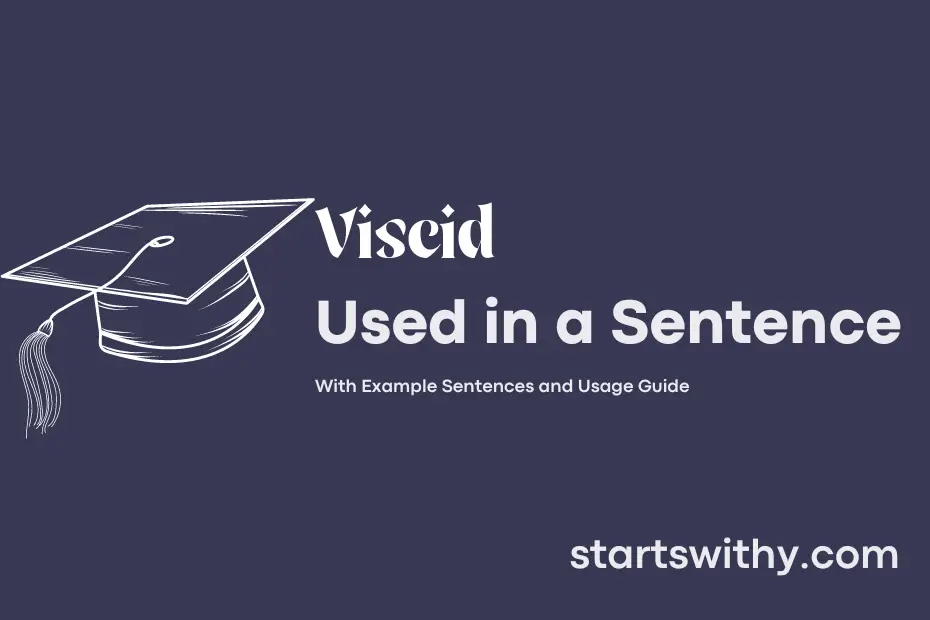Ever struggled to separate two sticky pages of a well-loved book? That’s the essence of “viscid” – a term used to describe something thick and adhesive in nature.
When an object or substance is described as viscid, it typically denotes a high level of stickiness or viscosity. This word is often used to depict materials like glue, syrup, or even certain types of slime.
7 Examples Of Viscid Used In a Sentence For Kids
- The viscid slime stuck to the frog’s skin.
- The viscid glue helped the paper stick to the wall.
- The snail left a viscid trail behind as it crawled.
- The honey was viscid and sweet.
- The syrup was viscid, making it hard to pour.
- The viscid pudding was difficult to stir.
- The viscid sap oozed from the tree when it was cut.
14 Sentences with Viscid Examples
- Viscid glue is often used in crafting projects for college assignments.
- Make sure to clean off any viscid residue left behind from sticky notes on your study desk.
- The viscid texture of traditional Indian sweets can be enjoyed during festive celebrations on campus.
- Avoid spilling the viscid oil when conducting chemistry experiments in the laboratory.
- It’s important to handle viscid substances carefully in the biology lab to prevent accidents.
- The monsoon season in India can bring about viscid mud on campus pathways, so be cautious while walking.
- Some students prefer using viscid hair gel to style their hair for college events and functions.
- The cafeteria may serve viscid curry dishes that are popular among students seeking traditional flavors.
- When printing papers in the computer lab, be mindful of any viscid toner that may leak onto your hands.
- The campus bookstore sells viscid tape and other stationery items for student convenience.
- During art classes, students experiment with various viscid paints to create colorful masterpieces.
- Viscid honey is a popular addition to morning tea for students looking for a natural sweetener.
- Keep a bottle of viscid hand sanitizer in your bag to maintain hygiene while on campus.
- When working with viscid clay in pottery classes, students can create unique sculptures and pottery pieces.
How To Use Viscid in Sentences?
To use the word Viscid in a sentence, you can describe something that is thick and sticky. For example, “The viscid mixture of honey and glue made it difficult to separate the pages of the book.”
When incorporating Viscid into a sentence, consider the context of the word and ensure it fits naturally within the sentence. You can use Viscid to describe substances like syrup, glue, or any other thick, adhesive material.
Additionally, you can use Viscid metaphorically to describe situations or relationships that are difficult to navigate or escape from, similar to being stuck in a sticky situation.
Remember to place Viscid in a sentence where it accurately describes the texture or nature of the substance or situation you are referring to. Experiment with using Viscid in different types of sentences to get comfortable with incorporating it into your vocabulary.
With practice, you will become more confident in using Viscid in various contexts to effectively convey your thoughts and descriptions. Over time, you will find that Viscid can be a versatile and descriptive term to enhance your writing and communication skills.
Conclusion
In conclusion, sentences containing the word “viscid” describe substances or materials that are thick and sticky in nature. These sentences often convey the physical attributes of such substances, highlighting their adhesive or viscous qualities. “The viscid texture of the honey clung to the spoon as it was stirred” and “The spider silk was remarkably viscid, trapping unsuspecting insects in its sticky strands” are examples that illustrate the usage of “viscid” in context.
Overall, the word “viscid” is a descriptive term used to characterize the stickiness or thickness of various substances, creating vivid imagery in writing. Its inclusion in sentences enhances the reader’s understanding of the texture and consistency of the material being described, making it a valuable addition to descriptive language.



